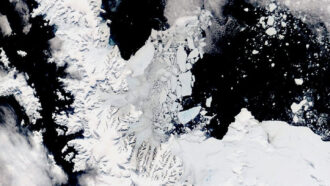When the moon throws shade, the weather can change
From plummeting temps to wind and cloud changes, solar eclipses can trigger wacky weather
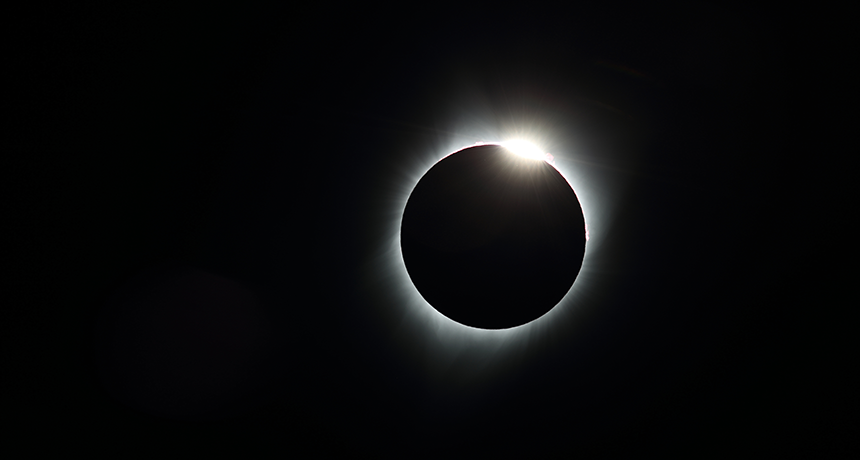
Frank Fichtmüller/iStockphoto
On August 21, 2017, the moon cast a temporary shadow across a wide swath of the United States. The event spanned 14 states and lasted for up to two minutes 41 seconds in any one spot. Many areas were plunged into brief, total daytime darkness. Others experienced a subtle, hour-long partial dimming of the sun.
As millions of people along the eclipse path watched in awe, cadres of scientists went to work. The moon reduced — and in some places blotted out — warming rays of the roughly midday sun. Some scientists were looking to log local weather changes. Not surprisingly, scientists now report, the eclipse produced a localized short-term cooling along its path.
But that was not all.
Wind speeds changed. Some clouds evaporated in the abrupt cooling. In all, the rare spectacle provided loads of useful data to researchers who are trying to better understand how the globe responds when the sun’s light briefly disappears.
The most easy-to-measure changes were drops in air temperatures at Earth’s surface.
The Kentucky State Mesonet is a network of 68 automated weather stations. They span the state. These stations measured temperature, winds and intensity of sunlight every three seconds throughout the eclipse.
The station in Hopkinsville fell in the center of the shadow’s path. It got to feel the eclipse’s full impacts. Totality is the brief, spectacular event where the sun’s rays are fully blocked and no sunlight reaches the ground. Ten minutes after totality had ended in Hopkinsville, the air had cooled by 4.4 degrees Celsius (8 degrees Fahrenheit). It would take another 75 minutes to warm back up again.
Story continues below graph.
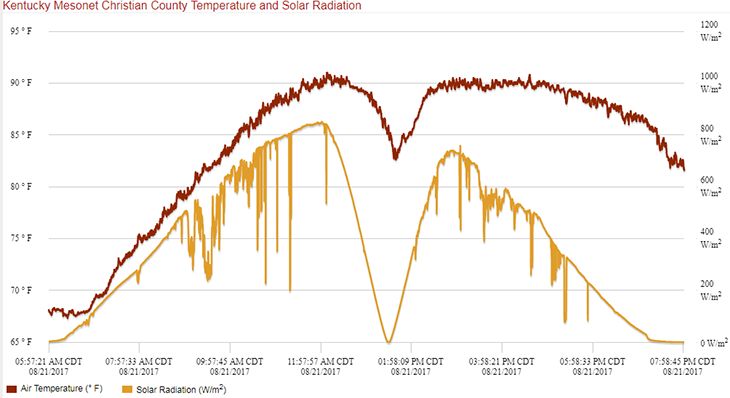
As these data show, that drop in temperature tends to lag the moon’s shadowing by several minutes. That’s because of the way air is warmed. The sun doesn’t heat the air. Instead, it radiates energy that warms the ground. That heated soil soon warms the air immediately above it. Shortly after that, the surface air will move the heat — through a process known as convection — up into the atmosphere. This entire process takes a few minutes. That’s why the maximum temperature drop does not occur at the point of maximum shade.
In dry climates, the sudden cool-down from an eclipse can be even more dramatic.
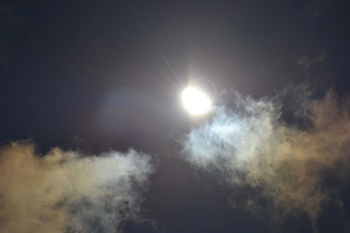
Dan Satterfield is the chief meteorologist at WBOC-TV in Salisbury, Md. He traveled to Alliance, Neb., to watch the eclipse. There, he recorded a 5 degree C (9 degree F) decline in air temps. “It was a bit more than I expected actually,” he now recalls. “But then I realized that we were at over 4,000 feet [1,219 meters] elevation.”
Air tends to be drier at higher altitudes. That cooler air, higher up, can hold less water. Water takes a long time to gain or lose heat, Satterfield points out. Air on its own, though, can’t hold onto heat very effectively. Dry air loses a lot of heat as soon as the sun is gone. That means that drier air can see faster and more dramatic warming and cooling.
This explains why eclipse-driven temperature swings can be really dramatic in very dry air. Such as Lusaka in Zambia. This arid capital in South Central Africa saw a total eclipse of the sun on June 21, 2001. That event briefly brought a whopping 8.3 degree C (15 degree F) drop in temperature.
Changing winds and cloud cover
Scientists measure the amount of incoming sunlight in watts per meter squared. A typical value would be around 800 W/m&³2;. At sites in the path of last year’s total eclipse, the number briefly dipped to zero. Confused birds returned to their roosts. Crickets began to chirp as they thought night had come early.
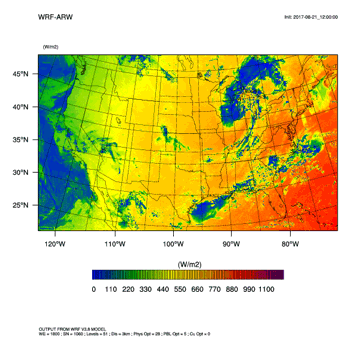
And at some sites, a cool breeze blew in from the west. That’s where the moon’s shadow was sweeping in from. This rapid false nightfall in places churned up air currents. Many researchers reported feeling an “eclipse wind” — something that had been mentioned in folklore for ages. Scientists are still analyzing data, but they noted an abrupt wind shift falling in the wake of the shadow’s passage.
Sometimes, though, the opposite happens: A total solar eclipse can bring a calming of the winds. That’s what Suzanne Gray and Giles Harrison reported two years ago in the Proceedings of the Royal Society A. These research meteorologists work in England at the University of Reading. They studied a total eclipse over the British Isles on March 20, 2015. And their data showed that wind speeds did not rise. They dropped.
Clouds, too, may be affected.
White, puffy summertime clouds often dot the afternoon sky. But during the 2017 solar eclipse, these all but vanished over much of the United States. Scientists at many sites charted what was happening. Then they compared these data to what computer programs had been forecasting.
First, those forecasts: In the days before the eclipse, scientists had been running computer models — programs to project what might occur. Each run of the computer program had been based on the anticipated weather and eclipse shadows. Computer models know how air temperature responds to the amount of sunlight coming in. Even though scientists knew that the sun would be blocked, they had to rely on computer models to predict how this might affect temperatures.
The U.S. National Weather Service uses one computer model for this. It’s known as the HRRRX (High Resolution Rapid Refresh Experimental) model. Meteorologists run it once an hour, feeding it constantly updated data. Always reflecting the latest conditions, scientists consider it the most accurate U.S. tool for forecasting weather.
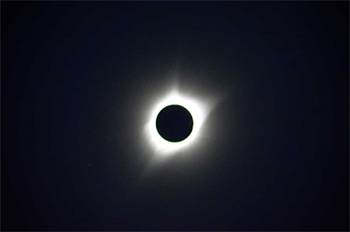
Astronomers made calculations of how much the sun would be dimmed. Then they passed this information to programmers to feed into the model runs in the days before the eclipse. Indeed, short-range weather models have now been adjusted to include all eclipses through the year 2050. Before this, weather models had ignored the role of any eclipse.
One spectacular image from the Earth Systems Research Laboratory in Boulder, Colo., shows the difference in what the model had forecasted before and after the update. The original version of HRRR and other models had predicted a large thunderstorm cluster — known as a complex — to rumble through Nebraska on eclipse day. It never happened, thanks to the dimming of the sun. And the newly tweaked HRRRX model had warned this might not occur.
What seems to have happened is that the eclipse’s sharp cutoff of sunlight prevented most surface air from rising. This halted updrafts. These are pockets of air that bubble upwards. Normally, these updrafts feed the puffy cumulus clouds that can emerge in the heat of the day.
From the ground, people in many places reported seeing clouds thin somewhat before the eclipse reached totality. In other words, as the incoming sunlight shrank, so did the mass of the clouds.
The National Oceanic and Atmospheric Administration captured an incredible video of this from its GOES-16 weather satellite. That video showed a white patchwork of clouds over the U.S. Gulf Coast and southeastern states. As soon as the eclipse’s shadow moved past this area, the sea of white dissolved. It left clear blue skies in its wake.
On average, a total solar eclipse occurs at any particular site only about once every 375 years. That makes it a pretty rare event. But for those that missed the 2017 eclipse, don’t despair. Americans will have another shot close to home on April 8, 2024. And if you’re more adventurous and don’t mind hiking across the globe, pack your bags. A total solar eclipse will throw some serious shade at Chile and Argentina in July 2019.
In this video-diary entry for the Washington Post, the author and meteorologist Dan Satterfield witness the 2017 eclipse.
M. Cappucci/Washington Post






